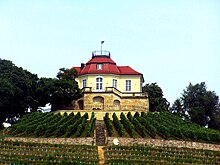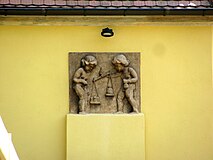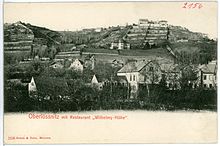House in the sun
The house in the sun , formerly also Friedrichsburg and Bergschlösschen , is a vineyard house built in 1770 in the Oberlößnitz district of the Saxon city of Radebeul . The since 1939 listed country house located in the vineyard Road 44, within the Historical Conservation Area Historical vineyard landscape Radebeul .
description

The core building is a two-storey building with a hipped roof , a polygonal porch with a mansard tent roof is built in front to the south and north , giving the impression of a tower. At the top of the top is a weather vane that shows the date of 1770 and the three initials of the owner at the time ( CGSor GCS). In Gurlitt's fundamental inventory for the Lößnitz villages from 1904 , the art monument listed at Obere Bergstrasse No. 88 still bore the initialsG.S.
The plastered ground floor is massive and stands on a quarry stone plinth, the also plastered upper floor made of half-timbering has been completely boarded up again since the 1920s, after Gurlitt reported in 1904 that the boarding was partially missing.
Behind the arched windows of the porch on the ground floor is a painted garden room. The entire vineyard house now houses 17 rooms and 5 bathrooms, the property is around 12,000 m².
A single-storey wing (studio) with a mansard roof and a transverse building with a hipped roof extends to the west . There is a stand bay on the east side . Further additions extend to the north.
Reliefs are set into the facade of the house in the sun , two with agricultural motifs and one with two putti with scales that weigh the house and a wallet. Above the entrance on the north side there is the slogan non mihi sed posteris (not for me, but for the descendants).
From its shape to that sees home in the sun like a model from later on for a few months in the West Neufriedstein resulting Mätressenschlösschen .
Home in the sun, from the Cikkurat from
history
In 1770, the electoral Saxon coin factor Georg Christian Städter (or Stätter) had the baroque vineyard house built as a mansion on his winery, the Kröberischer Weinberg (later also Krebelscher Weinberg ) . The summer residence was built by the Hoflößnitz master mason Heerklotz and the Königstein carpenter Gottschalk. A farm building with a wine press and wine cellar stood further north on the property. The buildings have been expanded several times since 1790. In the first half of the 19th century the property was owned by the merchant Friedrich Zembsch, who also owned the winery ( Haus Steinbach ) at the foot of the vineyard . Zembsch named the building Friedrichsburg .
After the phylloxera disaster in the mid-1880s, the building was divided into five apartments at the beginning of the 20th century.
In 1917 the architect Martin Hammitzsch , who became famous for building the Yenidze in Dresden , bought the property together with his first wife Marie. In 1920/1921 he redesigned the house in the style of homeland security architecture and expanded it to a spacious country house on the west, north and east sides. At that time, he gave the house its current name, House in the Sun, due to its exposed south-facing location. He also had parts of the vineyard cultivated again. During the renovation period, Hammitzsch lived in the nearby Weinbergstrasse 48 .
In 1936 he married Angela Verw. Raubal born Hitler (1883–1949), Adolf Hitler's half-sister . In 1937 or 1938 he sold the house in the sun to the German Labor Front and moved to Dresden; in 1939 he was registered as the owner in the Radebeul address book. In 1939 the house was placed under a preservation order. In 1940 the German Labor Front sold the property to Heinsius von Mayenburg Verwaltungsgesellschaft mbH, which was connected to the Dresdner Leowerken .
During the GDR the property belonged to the VEB Elbe-Chemie . After 1990, the heirs of the oral hygiene company, which was nationalized in 1952, got their property back, which they sold in 1993 to a Radebeul building contractor, who renovated the decaying building and moved in with his family. In May 2009 he announced that "the house was too big for him and he wanted to sell it."
The vineyard is now part of the Hermannsberg , which belongs to the Radebeuler Goldener Wagen single vineyard site within the Radebeuler Lößnitz site .
"Friedrichshöhe in Oberlößnitz". Engraving from the estate of the merchant Zembsch , left. the winery, right the villa, in front of it the street runs. In the center left: House in the sun. Before about 1850
As in 1901, right above Wilhelmshöhe
From afar. Clockwise: Wilhelmshöhe (at 1 a.m.), Winzerhaus Hofmannsberg (3:30 a.m.), Weinbergstrasse 46 (4), Villa Friedenshain (6, only roof), Villa Oswald Haenel (7), Bennoschlösschen (7), Hohlweg 88b (9 a.m.) )
literature
- Frank Andert (Red.): Radebeul City Lexicon . Historical manual for the Loessnitz . Published by the Radebeul City Archives. 2nd, slightly changed edition. City archive, Radebeul 2006, ISBN 3-938460-05-9 .
- Matthias Donath , Jörg Blobelt (photos): Saxon wine country . Historic wineries and vineyard houses in the Elbe Valley. 1st edition. Editorial and publishing company Elbland, Dresden 2010.
- Cornelius Gurlitt : Oberlössnitz. More vineyards. Obere Bergstrasse No. 88. In: Descriptive representation of the older architectural and art monuments of the Kingdom of Saxony. 26. Booklet: The art monuments of Dresden's surroundings, Part 2: Amtshauptmannschaft Dresden-Neustadt . CC Meinhold, Dresden 1904, p. 156.
- Volker Helas (arrangement): City of Radebeul . Ed .: State Office for Monument Preservation Saxony, Large District Town Radebeul (= Monument Topography Federal Republic of Germany . Monuments in Saxony ). SAX-Verlag, Beucha 2007, ISBN 978-3-86729-004-3 .
Web links
Individual evidence
- ↑ Monument registration 08950218. Retrieved on November 27, 2019.
- ↑ Volker Helas (arrangement): City of Radebeul . Ed .: State Office for Monument Preservation Saxony, Large District Town Radebeul (= Monument Topography Federal Republic of Germany . Monuments in Saxony ). SAX-Verlag, Beucha 2007, ISBN 978-3-86729-004-3 , p. 74 as well as enclosed map .
- ↑ a b c Matthias Donath, Jörg Blobelt (photos): Sächsisches Weinland . Historic wineries and vineyard houses in the Elbe Valley. 1st edition. Redaktions- und Verlagsgesellschaft Elbland, Dresden 2010, p. 184-186 .
- ↑ a b c d Famous Radebeul villa is being sold in Sz-online.de on April 20, 2009.
- ↑ Liselotte Closer (Erarb.): Radebeul - City guide through past and present . 1st supplemented edition. Edition Reintzsch, Radebeul 2008, ISBN 978-3-930846-05-4 , pp. 70 .
- ↑ Liselotte Closer (Erarb.): Radebeul - City guide through past and present . 1st supplemented edition. Edition Reintzsch, Radebeul 2008, ISBN 978-3-930846-05-4 , pp. 71 .
- ↑ The Hitler's: The Leader's Unknown Family. By Wolfgang Zdral
- ↑ Volker Helas (arrangement): City of Radebeul . Ed .: State Office for Monument Preservation Saxony, Large District Town Radebeul (= Monument Topography Federal Republic of Germany . Monuments in Saxony ). SAX-Verlag, Beucha 2007, ISBN 978-3-86729-004-3 , p. 302 .
- ↑ Dresden Address Book, Appendix Radebeul Address Book, p. 122. ( Memento of the original from October 1, 2016 in the Internet Archive ) Info: The archive link has been inserted automatically and has not yet been checked. Please check the original and archive link according to the instructions and then remove this notice.
- ^ Frank Andert: The first sanatorium of the Lößnitz? . in: Preview and Review, October 2008. Radebeuler Monatshefte eV, Radebeul 2008.
Coordinates: 51 ° 6 ′ 43 ″ N , 13 ° 40 ′ 25 ″ E









